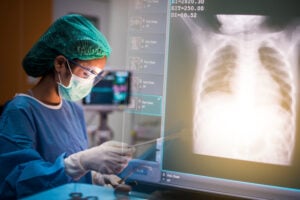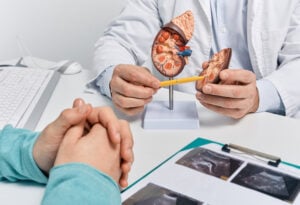According to the WHO cancer report, close to 18 million people worldwide were diagnosed with cancer in 2018, with about a million more men than women. This is a significant global public health burden, straining treatment facilities and reducing overall life expectancy figures. Prevention of cancer is at the forefront of health initiatives, including healthy living, increasing physical activity, paying attention to nutrition and body weight, and reducing alcohol intake and smoking.
Carcinomas are the most commonly diagnosed cancer and they occur in the skin, organs, and glands. Leukaemia is a cancer of the blood and lymphomas are cancers of the lymphocytes. Sarcomas occur in bone and soft tissue but are uncommon, as are melanomas that develop in the skin’s pigment cells.
The ten most prevalent cancers, with their risk factors and signs and symptoms, are:
1. Lung Cancer
Lung cancer is the leading cause of cancer death in both men and women, accounting for a quarter of all cancer deaths. More people die of lung cancer than breast, colon and prostate combined. With over 2 million cases diagnosed per annum, lung cancer constitutes 12.3% of all cancers. Risk factors include smoking, passive smoking and exposure to radon and certain chemicals.
Common signs and symptoms: A persistent cough, chest pain, wheezing, shortness of breath, coughing up blood or bone pain could indicate lung cancer. Less frequent signs include voice changes, headaches, blood clots, frequent lung infections and unexplained weight loss.
2. Breast Cancer
Breast cancer is the most common form of cancer in women and contributes to 25.4% of all female cancers, with over 2 million new cases diagnosed annually. Breast cancer survival rates vary greatly around the world with North America at over 80%, Sweden and Japan at 60% and low-income countries below 40%.
Common signs and symptoms: A new lump or swelling in the breast, painful nipples or discharge, dimpling or other skin changes, nipple retraction or lumps around the armpit or collarbone need to be investigated.
3. Colorectal Cancer
1.8 million people are diagnosed annually with colorectal cancer, and incidence rates for people under 50 are rising by 2 per cent annually. Scientists are perplexed by this, and many factors have been hypothesised about the causes of colorectal cancer, such as diets high in red meat, fat and sugar, excessive alcohol intake, inactive lifestyle, genetics and more. Notably, the tragic death of black panther actor Chadwick Boseman was from colon cancer at the age of 43.
Common signs and symptoms: Changes in bowel habits, pain or pressure in the abdomen or rectum, blood in the stool or rectal area, exhaustion and weakness and unexplained weight loss require investigation.
4. Prostate Cancer
Prostate cancer is the most commonly diagnosed cancer in men in the UK and America, but early-stage detection offers an excellent chance of living cancer-free. 1 in 9 men and trans women will have prostate cancer during their lifetime. Unfortunately, there is a disproportionate impact of prostate cancer on African-American men, who are considered to be at higher risk.
Common signs and symptoms: Pain on urination or ejaculation, pressure or pain in the rectal area, lower back or pelvic area, erectile dysfunction, and most commonly, changes in urination processes – frequent urges, stream problems, leaking, interruption problems or blood in the urine.
5. Stomach Cancer
About a million new cases of stomach cancer are diagnosed annually. Risk factors include gastritis from H. pylori infections, polyps and bleeding ulcers, intestinal metaplasia, genetic factors, and vitamin B12 deficiency. Furthermore, smoking, a high intake of salty, pickled or smoked foods, obesity, type A blood, certain viral infections, exposure to asbestos, and working in metal, timber, rubber or coal industries increase the risks. Most gastric cancers start in the stomach lining and can spread to other organs.
Common signs and symptoms: Digestive problems such as indigestion, bloating, heartburn, nausea, and appetite loss are early signs. Fluid in the abdomen (ascites), enlarged lymph nodes or nodules under the skin and difficulty swallowing require investigation.
6. Liver Cancer
Over 840,000 patients are diagnosed annually, a prevalence of 5.0%. Liver cancer incidence rates have tripled since the 80s and are three times more frequent in men than women. Reducing alcohol intake, a hepatitis B vaccination and regular testing for hepatitis C can reduce risk.
Common signs and symptoms: A swollen abdomen, nausea and vomiting, yellowing of the skin or eyes, abnormal bruising or bleeding, itchy skin, unexplained weight loss, weakness, dizziness, confusion, fever and pain in the gut or right shoulder blade are all signs of liver cancer. An examination of a person with liver cancer will reveal a swollen liver and spleen.
7. Oesophagus Cancer
Oesophageal cancer has a prevalence of 3.4%, with over half a million new diagnoses annually. The oesophagus is the long narrow tube that runs from your throat to your stomach, and cancer usually starts in the oesophagus lining. It is more common in men and is attributed to tobacco, alcohol use, obesity, and specific nutritional habits.
Common signs and symptoms: The most common symptoms include difficulty swallowing, indigestion, heartburn, pain, pressure or burning in the chest, coughing, and unexplained weight loss.
8. Cervical Cancer
With over half a million women diagnosed annually, cervical cancer is among the most common cancers. Screening tests and the HPV vaccine can help prevent it.
Common signs and symptoms: Cervical and uterine cancers do not cause signs and symptoms early on. Often the first sign is bleeding after sexual intercourse or blood and other discharge.
9. Thyroid Cancer
With a prevalence of 3.3% and over half a million new cases per annum, thyroid cancer can best be prevented by avoiding unnecessary radiation exposure around the head and neck, particularly in young children.
Common signs and symptoms: The first sign is usually a lump or swelling in the front of your neck. Voice changes, a constant cough, pain radiating up your neck and trouble swallowing or breathing need investigating.
10. Bladder Cancer
With over half a million cases per year and a prevalence of 3.2%, bladder cancer is most commonly caused by smoking, exposure to chemicals, or genetic mutations.
Common signs and symptoms: Blood in the urine (colour changes) is the first sign of bladder cancer. Changes in urination patterns could also indicate a need for testing, such as pain, a weak stream, or struggling to urinate.
Not all signs and symptoms mean you have cancer but do not ignore unexplained weight loss, extreme fatigue, and changes in bodily habits. Cancer screening services are used to detect cancer even before symptoms appear, so it is crucial to undergo screening early. There is no right age to begin cancer screening, but it is highly encouraged in adults over 50 or even less, especially if you have a first-degree relative who has been diagnosed with cancer.
As always, consult with your local physician or a specialist Oncologist for the most appropriate medical advice.















